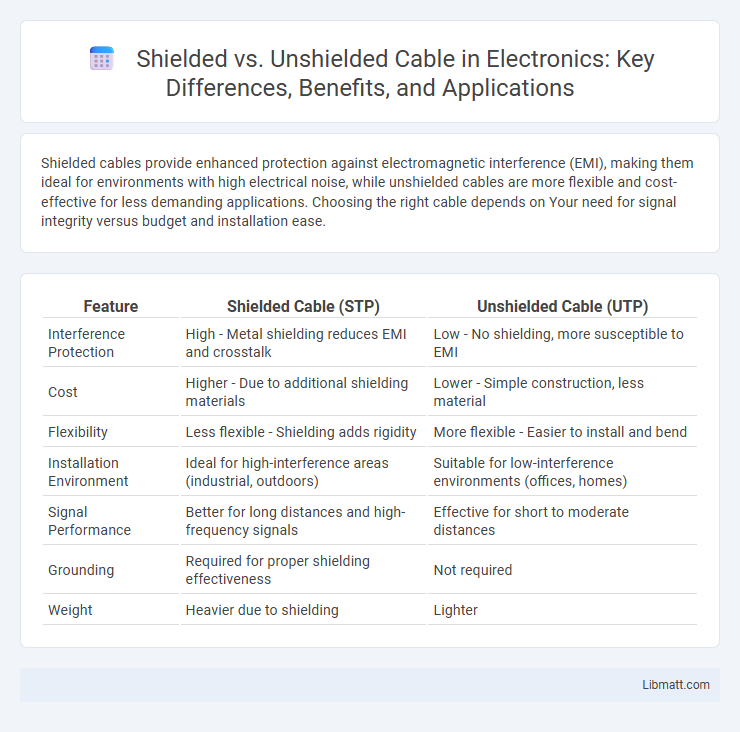Shielded cables provide enhanced protection against electromagnetic interference (EMI), making them ideal for environments with high electrical noise, while unshielded cables are more flexible and cost-effective for less demanding applications. Choosing the right cable depends on Your need for signal integrity versus budget and installation ease.
Table of Comparison
| Feature | Shielded Cable (STP) | Unshielded Cable (UTP) |
|---|---|---|
| Interference Protection | High - Metal shielding reduces EMI and crosstalk | Low - No shielding, more susceptible to EMI |
| Cost | Higher - Due to additional shielding materials | Lower - Simple construction, less material |
| Flexibility | Less flexible - Shielding adds rigidity | More flexible - Easier to install and bend |
| Installation Environment | Ideal for high-interference areas (industrial, outdoors) | Suitable for low-interference environments (offices, homes) |
| Signal Performance | Better for long distances and high-frequency signals | Effective for short to moderate distances |
| Grounding | Required for proper shielding effectiveness | Not required |
| Weight | Heavier due to shielding | Lighter |
Introduction to Shielded and Unshielded Cables
Shielded cables contain a conductive layer that protects data transmission from electromagnetic interference (EMI), making them ideal for environments with high electrical noise. Unshielded cables lack this protective layer, offering flexibility and cost-effectiveness for everyday applications with minimal interference. Choosing the right cable depends on your specific needs for signal integrity and environmental conditions.
Understanding Shielded Cables
Shielded cables contain a conductive layer, often made of braided copper or aluminum foil, designed to protect transmitted signals from electromagnetic interference (EMI) and radio frequency interference (RFI). These cables are essential in environments with high electronic noise, such as industrial settings or near heavy machinery, ensuring signal integrity and reducing data transmission errors. The shielding in these cables helps maintain optimal network performance, especially in high-speed data communication systems like Ethernet and audio-video applications.
Features of Unshielded Cables
Unshielded cables feature a simple design without metallic shielding, making them lightweight and flexible for easier installation in diverse environments. They provide adequate protection against electromagnetic interference (EMI) in low to moderate noise settings, making them ideal for office and residential networking. Cost-effective and widely used in Ethernet and telephone wiring, unshielded cables support reliable data transmission over short to medium distances.
Key Differences Between Shielded and Unshielded Cables
Shielded cables feature a protective layer of conductive material that reduces electromagnetic interference (EMI), enhancing signal quality and making them ideal for high-frequency or noisy environments. Unshielded cables lack this protective layer, offering greater flexibility and lower cost, but are more susceptible to EMI, best suited for low-interference settings. Choosing the right cable ensures Your network maintains signal integrity and performance based on environmental factors and application requirements.
Electromagnetic Interference: Protection and Risks
Shielded cables provide superior protection against electromagnetic interference (EMI) by incorporating conductive layers that block external noise and prevent signal degradation. Unshielded cables lack this protective barrier, making them more vulnerable to EMI, which can result in data loss, reduced performance, and erratic signal transmission. In high-EMI environments such as industrial settings or near heavy machinery, shielded cables significantly reduce the risk of interference-related issues, ensuring reliable communication and maintaining signal integrity.
Applications Best Suited for Shielded Cables
Shielded cables are best suited for applications involving high levels of electromagnetic interference (EMI), such as industrial environments, medical equipment, and audio/video installations where signal integrity is critical. Your sensitive data transmissions in environments with heavy machinery or radio frequency emissions benefit from the protective shielding, preventing crosstalk and external noise. These cables enhance performance in networking, automotive, and aerospace systems that demand robust noise resistance and signal clarity.
Ideal Scenarios for Unshielded Cable Use
Unshielded cables are ideal for residential wiring, office environments, and low-interference settings where electromagnetic and radio frequency interference are minimal. These cables offer cost-effective and flexible solutions for voice, data, and video transmissions in short-distance runs without the need for heavy protection. They are commonly used in local area networks (LANs), telephone systems, and home entertainment setups where cable flexibility and ease of installation are priorities.
Performance and Signal Integrity Comparison
Shielded cables significantly reduce electromagnetic interference (EMI) and radio frequency interference (RFI), enhancing signal integrity and overall performance in high-noise environments. Unshielded cables, while more flexible and cost-effective, are more susceptible to crosstalk and external noise, potentially degrading signal quality over long distances or in electrically noisy settings. For applications demanding high data fidelity and minimal signal loss, shielded cables provide superior performance compared to unshielded counterparts.
Cost Considerations: Shielded vs Unshielded Cables
Shielded cables generally incur higher costs due to the additional materials and manufacturing complexity involved in incorporating protective metal layers that reduce electromagnetic interference. Unshielded cables are typically more affordable and easier to install, making them suitable for environments with minimal interference concerns. Choosing between shielded and unshielded cables depends on balancing budget constraints with the need for signal integrity in specific operational settings.
Choosing the Right Cable for Your Network
Selecting the right cable for your network depends on your environment's interference levels and performance requirements. Shielded cables (STP) offer superior protection against electromagnetic interference (EMI), making them ideal for industrial or high-EMI areas, while unshielded cables (UTP) provide cost-effective and flexible solutions for standard office or home networks. Your choice directly impacts data integrity, network speed, and overall reliability, ensuring optimal connectivity tailored to your setup.
Shielded vs Unshielded cable Infographic

 libmatt.com
libmatt.com